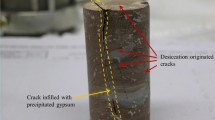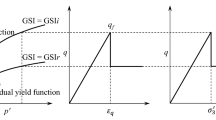Summary
Design and construction of tunnels in swelling rock may be considered to be a matter of choosing the right tunnel cross-sectional form and the appropriate excavation methods and sequences. Experience, i. e. empirical knowledge, no doubt plays a fundamental role in tunnelling and even more so in tunnelling in swelling rock formations. However, the design engineer needs some tools to analyze the forces which are transmitted from the swelling rock to the tunnel lining in a given case. These tools may provide approximations of the real behavior. However, approximate quantitative indications are very valuable in order to supplement the mentioned empirical knowledge. The analysis method given in the paper is meant to provide such a tool for circular tunnels in swelling rock of the reversible type (swelling of clay minerals). The main approximation of the method is the consequent use of the theory of elasticity as framework for the specific swelling calculations. Since the widely used oedometer swelling test until now is also interpreted using the theory of elasticity, the analysis method is compatible with the kind of assessment of the swelling parameters.
The main advantage of the method, however, is its relative simplicity because it may be used quite similarly to the method of “characteristic lines”. In principle, the method could be transformed into an elasto-plastic approach. As long as the greatest uncertainty of the design methods, however, lies in the right choice of the swelling parameters, a too complicated analysis method is hardly beneficial. For complex cases, where the geometrical boundary conditions may not allow the use of a circular tunnel model, it is advisable to use finite element solutions which are available for swelling calculations in the elasto-plastic formulation straight away.
Similar content being viewed by others
References
Bronstein, I.N., Semendjajew, K.A. (1976): Taschenbuch der Mathematik. Verlag Harri Deutsch; Zürich, Frankfurt a. M., Thun.
Einstein, H. H. et al. (1972): Verhalten von Stollensohlen in quellendem Mergel. Proceedings on Internal Symposium on Underground Works, Lucerne, 296–319.
Gysel, M. (1977): A Contribution to the Design of a Tunnel Lining in Swelling Rock. Rock Mechanics,10, 55–71.
Morgan, H.D. (1961). A Contribution to the Analysis of Stress in a Circular Tunnel. The Institution of Civil Engineers, London.
Muir Wood A.M. (1975): The Circular Tunnel in Elastic Ground. Géotechnique,25 (no. 1), 115–127.
Timoshenko, S.P., Goodier, J.N. (1970): Theory of Elasticity. 3rd Ed. New York: McGraw-Hill.
Wittke, W., Rissler, P. (1976): Dimensioning of the Lining of Underground Openings in Swelling Rock Applying the Finite Element Method. Publications of the Institute for Foundation Engineering, Soil Mechanics, Rock Mechanics and Waterways Construction, Vol. 2, RWTH Aachen.
Author information
Authors and Affiliations
Rights and permissions
About this article
Cite this article
Gysel, M. Design of tunnels in swelling rock. Rock Mech Rock Engng 20, 219–242 (1987). https://doi.org/10.1007/BF01024643
Issue Date:
DOI: https://doi.org/10.1007/BF01024643




